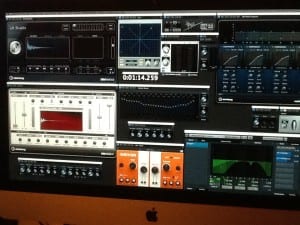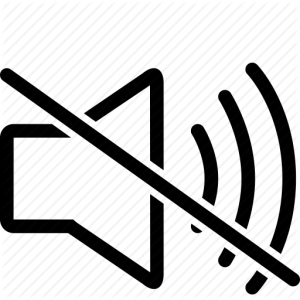Visiting the artist this evening proved a surprise, as always. Joss sticks were burning and the customary growing pile of plugin cables and empty cups had been cleared away. Vacuuming had been done and the washing up was neatly stacked on the draining board. “Dylan? Come in” he shouted and I could sense a happy tone. He had prepared “my chair” even removing the cushion before I had chance to throw it on the floor ( I don’t do cushions).
“My chair” is a leather office style chair where I can lean back. It’s positioned in the centre of 2 high quality speakers at just the right height to get the best effect. We chat about the Frequency Festival while I glance at the timeline out of the corner of my eye, which is open on his top of the range Mac. It’s the main reason I am there, but I dont want to appear rude!
After about 10 minutes he thankfully grows bored of this small talk and prepares to play. I settle back in the same fashion as a patient may settle for a session of hypnotherapy. I close my eyes; the lights on the modules are mesmerizing but I want to listen and be drawn into the soundscape.  “It’s finished” he tells me. I get the impression that my critique of yesterday has prompted a remix. A click of the mouse and we are off.
“It’s finished” he tells me. I get the impression that my critique of yesterday has prompted a remix. A click of the mouse and we are off.
Normally I would include the audio at this point, but not today.  We are releasing it after our broadcast on Siren FM on Wednesday evening. I have listened and I think it’s damn good. I know that negates all my problems with value statements in yesterday’s post, and I will offer a more considered critique in a couple of days. However, it has movement and depth; it tells a Lincoln story which is ancient and contemporary. It’s an impression of the present and the future which has industrial strength and multicultural themes for the Lincoln of today.
We are releasing it after our broadcast on Siren FM on Wednesday evening. I have listened and I think it’s damn good. I know that negates all my problems with value statements in yesterday’s post, and I will offer a more considered critique in a couple of days. However, it has movement and depth; it tells a Lincoln story which is ancient and contemporary. It’s an impression of the present and the future which has industrial strength and multicultural themes for the Lincoln of today.
For me it’s been a intellectual journey of creative discussion, but for Steve the cleaning of his work space is symbolic of finishing hard graft. Mental stress is a tiring thing and he is exhausted. As you progress through your own creative journey you will realise just how much this kind of thing takes out of you.We listen to this work with fresh ears, but Steve has been listening to this almost exclusively for 7 weeks. I will update you soon on the publication of the audio which, as the recorders of the raw material, is as much your work as Steve’s. However, look at this which is a list view of the process he has gone through to get to this point.
Order of Work:
- Created project in Cubase 8 and populated with tracks, effects and processors – this to save time later and give a framework.
- Listened to source material for content and quality.
- Decided on base tempo considering the theme (yes this happened early on – as explained, a tempo that could be halved and still remain in the realms of feasibility).
- Re-listened to material several times for ideas and identifying unusual characteristics of clips.
- Made a start! This is important, even if the theme / work you start with is ditched later.
- Decided to start with an ambiguous, but rhythmic opening – this stopped me ‘painting myself into a corner’, which is a possibility with such a long piece.
- Started to put a loose palette of sounds together.
- Decided that because of the diversity of sounds that the piece will consist of many loosely related sections, segued together using location effects and musical memes.
- Continued to develop the piece, which starts to take the form of a journey as I considered the different locations of Lincoln, the social issues; particularly those surrounding the old being somewhat obscured by the new.
- Dynamics start to become evident as we have the more sedentary nature of the old town and green areas, compared to the traffic, train station and hustle bustle of the shopping areas.
- The opening rhythmic section and subsequent electric piano sound are echoed throughout the piece- as the work developed it started to become more cohesive, as backbone sections were fleshed out.
- The mix did not happen all at once – it was constantly worked on as part of the creative, sound sculpting process.
- At 25 minutes the piece has come full circle with a twist, with the Old England feel of the choirs and bells being replaced by an Eastern European / Middle Eastern themed vocal section. This signifies a diversity of cultures now found in Lincoln.
- EQ refinement and more subtle mixing took place.
- Ear candy added where appropriate.
- Some extra link material added.
- Stereo treatment applied
- All tracks check individually (solo’ed) for ‘clicks and pops. Fades and fade curves honed. (some clicks and aberrant noises could not be removed, so we live with them).
- Final mix.
- To do – mastering.
Areas of interest:
- Opening rhythm is high street ambience ‘stuttered’ by a square wave ‘tremolo’.
- Lots of percussion is derived from cutlery clanking, horses hooves, construction sounds, traffic airbrakes, train noises, footsteps, raindrops and other student sourced clanks and hits.
- Ambient sounds of feet in grass, birds, swans, bells, pipe organ (from Cathedral) and female(?) choir from the Cathedral are used along with recurrent bells, some natural, some re-piched to suit.
- A busker is used – only one line is isolated and manipulated, tuned, stretched and re-pitched.
- The train / travel section featured sounds of the station, trains, beepers, crossing point warnings and announcements.
- This section also tries to highlight the emotions of coming and going. There is a hurry, a happiness and sadness intermingled, but the overall sense is one of motion and moving. Conflict and resolution.
- The shopping centre section features warped voices, in-store advertising, busker, cash machines, checkouts and children in pushchairs along with snatches of conversation. The Big Issue crier is also here.
- The eastern section features some think voices, some manipulated. Francesca Genko provides the voice as a Native Instruments plug-in. Much work was undertaken with the raw samples to achieve the desired result.
- Some 50 tracks of audio where created, thank the Gods for mix automation!
General Instrumentation:
- Found Loops (student work)
- Guitar – Peavey with Floyd Rose Trem.
- Roland GR-55 Guitar Synth with PRS Guitar & Hex Pickup
- Eurorack Modular Synthesiser System (used throughout for sequences, bass, drums & processing)
Items used in Cubase 8 Pro:
Native Instruments Kontakt (full version) loaded with the following:
- “Cantus” (monks)
- “Francesca Genko” (female voice)
- “The Grandeur” (acoustic grand piano)
- “The Giant” (prepared piano),
- “Bohemian” (percussion)
- “Retro Instruments” (Rhodes Piano)
- “Rides” (cymbal splashes).
Other plug-ins in Cubase:
- Sternberg “Padshop Pro” Granular Synthesizer (used on guitar)
- Native Instruments Reaktor “Old Skool” (used for xylophone / percussive bleeps)
- Steinberg “Groove Agent SE-4” (used to put found hits into percussion synthesiser)
Various processors by Sternberg and Native instruments for EQ, Distortion, Compression, Echo, Modulation and Reverberation.